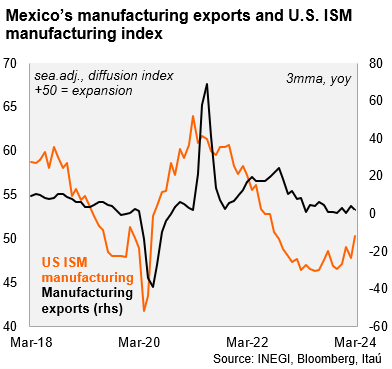The trade balance posted a surplus of USD 2.1 billion in March, above the market consensus of a surplus of USD 0.5 billion (as per Bloomberg) and our forecast of USD 1.1 billion. On a 12-month rolling basis, the trade deficit reached USD 3.5 billion in March (from a deficit of USD 4.4 billion in February and a deficit of USD 5.5 billion in 2023). The result is explained by a smaller energy trade deficit more than offsetting a narrower non-energy surplus. However, at the margin, using three-month annualized seasonally adjusted figures, the trade balance stood at a deficit of USD 15.0 billion in 1Q24 (from a surplus of USD 7.4 billion in 4Q23). Looking at the breakdown, manufacturing exports expanded 1.5% MoM/SA in March, with a positive momentum (qoq/saar of 2.5%). Non-energy imports fell by 0.8% MoM/SA dragged by intermediate imports, but with consumption and capital imports expanding. Non-energy imports momentum remained positive at 19.9% in 1Q24 (from -2.6% in 4Q23).
Our view: The trade balance data suggests further improvement in activity in March, as reflected by an expansion in manufacturing exports and non-energy consumption & capital imports, after a strong monthly GDP expansion in February. Still, given a weak activity January print, we expect a soft 1Q24 putting a downward bias to our 2024 GDP growth forecast of 2.8%. Our trade deficit forecast for 2024 of USD 17 billion, also has a downward bias (smaller deficit) considering a better-than-expected trade balance evolution in 1Q24 and a resilient external demand, although limited by a still strong currency.
See detailed data below



